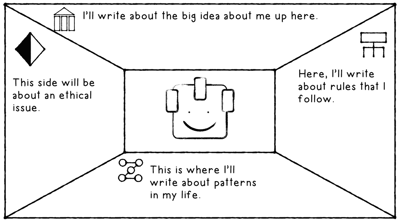A classic open-the-year task in many classrooms is for students to introduce themselves. This is also a nice way to introduce them to the prompts of Depth and Complexity.
At my school, teachers had their students make a frame graphic organizer. Then, the four sides would each represent one of the prompts of Depth and Complexity. Students would fill in information about themselves using those particular prompts to focus their thinking.

Don’t Keep Introducing!
Now, the caveat is, this is only useful as an introduction to Depth and Complexity. But it’s way too low-level for students who are already fluent with the D&C prompts. And, if last year’s teacher did it, and the teacher from two years ago did it, there’s no reason to keep doing this same introduction task! I taught 6th graders at an elementary school. Some of then had done this task every year since 1st grade.
What To Do Next?
So, if you have students who are already familiar with Depth and Complexity and perhaps have already done this very task in previous years, what you we do?
The answer is always to climb Bloom’s Taxonomy!
Let’s move from our low-level introduction task to the Analyze level of Bloom’s. (I think Analyze is the key to bridging low and high-level thinking).
Analyze
Analyze is all about comparing, contrasting, and categorizing. But this only works if we craft a high-level prompt! It can’t be “Compare yourself with your friend!” or we’ll get low-level responses like, “I have brown hair but they have black hair.”
Instead, let’s post everyone’s frames on the walls and spend time observing and thinking. Our Analyze task might be:
Tour the classroom and examine the Rules that your classmates follow. Look for Patterns within those Rules. Put the Rules your classmates follow into several categories. Not every Rule needs to fit into a category.
See how interesting this will be!? We have no idea what students will come up with. Perhaps one kid might notice that their classmates’ rules fall into the categories: family rules, legal rules, school rules, and religious rules. Another student might break the rules down into: “rules from me” and “rules from others.”
You can create a similar Analyze task for other prompts of Depth and Complexity.
- Group your classmates’ Unanswered Questions into several categories.
- Group your classmates’ Big Ideas into several categories.
But you’d only do one of these Analyze level tasks. Don’t make students categorize more than one prompt! That’s too much thinking and work. The higher up you go on Bloom’s, the more focused and narrow the questions must be.
What’s Next?
So, now that your class has put their classmates responses into categories, what’s next? We always want to be ready with the next level of Bloom’s (this helps avoid the “early finishers” problem).
Next, you can ask a question from the Evaluate level of Bloom’s. Good Evaluative questions always have specific criteria.
- 🚫 “What’s your favorite category of Rules?”
- ✅ “Which category of Rules is hardest for 5th graders to follow?”
- ✅ “Which category of Rules is most important in the long term but least important in the short term?”
- ✅ “Which category of Rules would Darth Vader be most interested in?”
Again, these are questions that, as a teacher, I’m actually interested in! What will my students say!? Each year, you can expect new and interesting responses.
And the key is to make sure that you’re always climbing up Bloom’s and staying specific with your tasks’ expectations.
